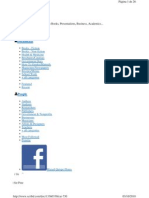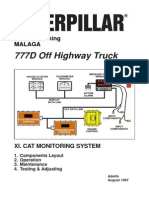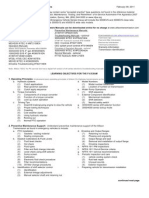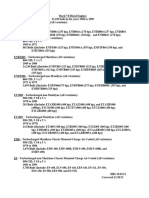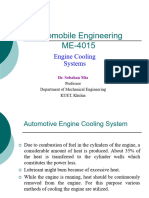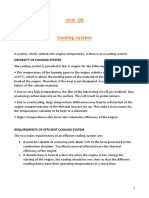Engine Systems 1
Engine Systems 1
Uploaded by
anuradhaCopyright:
Available Formats
Engine Systems 1
Engine Systems 1
Uploaded by
anuradhaOriginal Description:
Original Title
Copyright
Available Formats
Share this document
Did you find this document useful?
Is this content inappropriate?
Copyright:
Available Formats
Engine Systems 1
Engine Systems 1
Uploaded by
anuradhaCopyright:
Available Formats
Engine Systems 1
Engine Systems Introduction
This topic introduces the five principal engine systems.
Cooling System - What it Does
The primary function of the cooling system is to maintain correct engine temperature by taking
away unwanted heat generated by combustion and friction. The temperature of burning fuel in an
engine can exceed 3,500ºF (1,927ºC).
Even though diesel engines provide the most thermally efficient and cost effective power, only an
estimated 40% of the heat energy developed during combustion is converted into usable
horsepower. Of the remaining 60%, 7% radiates directly off engine surfaces, 23% goes out the
exhaust, and 30% is dissipated by the cooling system.
Coolant circulates through passages in the engine called the water or coolant jacket. The coolant
absorbs heat from the hot engine surfaces and carries it to the radiator where it is dissipated into
the atmosphere.
Cooling System - Heat Exchangers
A radiator is a form of heat exchanger, using air to dissipate heat from the cooling system. In
marine applications, another type of heat exchanger uses seawater to cool the engine. Instead of
using an air-cooled radiator to dissipate heat, seawater is pumped through one side of a heat
exchanger core. Engine coolant circulating in a closed system is pumped through the other side of
the heat exchanger where it is cooled, in later designs, by titanium plates that act like radiator fins.
Cooling System - Oil Coolers & Aftercoolers
The cooling system also helps maintain the correct temperature of the engine oil, transmission oil,
and hydraulic oil through the use of oil coolers. An oil cooler is a type of heat exchanger. With this
device, oil flows through a series of tubes surrounded by engine coolant that dissipates a portion
of the oil’s heat.
On Jacket Water Aftercooling (JWAC) systems, coolant from the engine is routed through the
aftercooler to cool the compressed air between the turbocharger and the intake manifold.
Engine coolant is also used to cool turbochargers.
Cooling System - Functions & Components
The water pump provides continuous circulation of coolant whenever the engine is turning. Water
pumps on most medium and large engines are gear driven; smaller engines use belt driven water
pumps.
A thermostat determines the flow of coolant to the radiator based on coolant temperature. In a
cold engine after start-up, the thermostat remains closed, forcing the coolant to bypass the
radiator or heat exchanger and only circulate within the engine block, cylinder head and oil coolers.
This enables the engine to warm up faster. When the engine reaches operating temperature, the
thermostat opens and coolant is routed through the radiator to be cooled.
The cooling system is a closed system that develops pressure as the coolant heats and expands.
Excess pressure is released through the radiator cap.
Lubrication System - What it Does
The engine lubrication system has three main functions:
To CleanTo CoolTo Seal and Lubricate
Oil cleans parts by carrying away damaging metal particles that materialize during normal engine
operations. Oil also cleans the cylinder walls and carries away carbon and lacquer deposits
produced during combustion. These particles are then removed from the lubricating system by the
engine oil filter.
The second function of oil is to cool parts by absorbing heat and carrying it away. Heat is then
dissipated in the oil pan or, more effectively, by an oil cooler.
Thirdly, oil forms a thin film or layer between the surfaces of moving parts to support and separate
them. This prevents metal-to-metal contact that causes excessive wear. Oil not only lubricates but
forms a dynamic seal that prevents airborne particles from penetrating.
You might also like
- 800 - Z8 (CF800) - Technical Service Manual PDFDocument296 pages800 - Z8 (CF800) - Technical Service Manual PDFKentNo ratings yet
- Autoflug Fuel en 2016 RZ WebDocument2 pagesAutoflug Fuel en 2016 RZ WebanuradhaNo ratings yet
- EWAD-TZ D-EIMAC00904-14 IOM Installation Manuals EnglishDocument229 pagesEWAD-TZ D-EIMAC00904-14 IOM Installation Manuals EnglishAmir ShamshiriNo ratings yet
- YK Operation ManualDocument206 pagesYK Operation ManualHumaid ShaikhNo ratings yet
- Lab 1Document3 pagesLab 1Mark MarkNo ratings yet
- 2017 Dacco Torque Catalog FBDocument620 pages2017 Dacco Torque Catalog FBAnonymous PZGUFq782% (11)
- Scania New Truck Generation: Technical Specification P360-A6X2 & P360-A6X4Document2 pagesScania New Truck Generation: Technical Specification P360-A6X2 & P360-A6X4Iccang DewiNo ratings yet
- D6K2Document20 pagesD6K2ivanamanticNo ratings yet
- Design, Analysis and Fabrication of Shaft Driven MotorcycleDocument10 pagesDesign, Analysis and Fabrication of Shaft Driven MotorcycleIJRASETPublicationsNo ratings yet
- Cat 914G2Document20 pagesCat 914G2t1me50% (2)
- Cat 730Document26 pagesCat 730Miguel Quispe Flores100% (1)
- Common Rail Diesel InjectionDocument2 pagesCommon Rail Diesel InjectionMOHITNo ratings yet
- 785 C IntroductionDocument10 pages785 C IntroductionAngela AllenNo ratings yet
- Event & Diagnostic Troubleshooting Guide v6Document18 pagesEvent & Diagnostic Troubleshooting Guide v6AliHabesNo ratings yet
- Engine Performance - Test - Engine Speed: Testing and AdjustingDocument2 pagesEngine Performance - Test - Engine Speed: Testing and AdjustingDANIEL VARGAS RODRIGUEZ100% (1)
- Engine Block Cleaning ProcedureDocument7 pagesEngine Block Cleaning ProcedureKamal PakdamanNo ratings yet
- Steering SystemDocument22 pagesSteering SystemAlexanderNo ratings yet
- Tecumseh Model Hm80 155128e Parts ListDocument11 pagesTecumseh Model Hm80 155128e Parts ListAndy TuranskyNo ratings yet
- Ignition System: From Wikipedia, The Free EncyclopediaDocument64 pagesIgnition System: From Wikipedia, The Free Encyclopediachiku16octNo ratings yet
- Hydraulic Systems: Unit 3Document29 pagesHydraulic Systems: Unit 3SahilNo ratings yet
- 2008 Norscot CatalogDocument12 pages2008 Norscot CatalogAdriano Godinho100% (2)
- Turbocompounding TechnologyDocument23 pagesTurbocompounding TechnologyPawan BeniwalNo ratings yet
- Piston Pump (Implement and Steering)Document2 pagesPiston Pump (Implement and Steering)kiddrix gamerNo ratings yet
- Engine Performance - Test - Engine Speed: 320D and 323D Excavators Hydraulic SystemDocument3 pagesEngine Performance - Test - Engine Speed: 320D and 323D Excavators Hydraulic SystemEm sulistio100% (1)
- Ignition System: Internal Combustion Engines Boilers Electric SparkDocument9 pagesIgnition System: Internal Combustion Engines Boilers Electric SparkManu ChakkingalNo ratings yet
- 4L80EDocument4 pages4L80EMario MastronardiNo ratings yet
- Product Line: Caterpillar Machines, Engines and Work ToolsDocument24 pagesProduct Line: Caterpillar Machines, Engines and Work Toolsagegnehutamirat100% (1)
- Engine CoolingDocument7 pagesEngine CoolingpradipNo ratings yet
- Power Units and TransmissionDocument42 pagesPower Units and TransmissionAmarjeet RaiNo ratings yet
- Do It YourselfDocument10 pagesDo It Yourselfbuggs1152No ratings yet
- Cat Engine DiagnosticsDocument3 pagesCat Engine DiagnosticsMirian NacipuchaNo ratings yet
- Ficha Tecnica d6tDocument28 pagesFicha Tecnica d6tWilmer Stiven MartinezNo ratings yet
- 988K-834-836K M04 EmissionSys EN SLDDocument38 pages988K-834-836K M04 EmissionSys EN SLDZul HermanNo ratings yet
- Hazpak Engine BrochureDocument8 pagesHazpak Engine BrochureEko AditiyaNo ratings yet
- Using The 8T-2700 Blowby/Air Flow Indicator (0774, 0781, 0785)Document34 pagesUsing The 8T-2700 Blowby/Air Flow Indicator (0774, 0781, 0785)Jorge Luis Cervantes Carrillo100% (1)
- 777D Off Highway Truck: Service Training MalagaDocument16 pages777D Off Highway Truck: Service Training MalagaEvan AT Yoel100% (1)
- Sebu6907-09 M - 24HDocument72 pagesSebu6907-09 M - 24HJose Miguel Salas Mariño100% (1)
- Cat 120 SpecalogDocument4 pagesCat 120 SpecalogPutraNo ratings yet
- Assignment On BANGLACATDocument6 pagesAssignment On BANGLACATBaygas MithuNo ratings yet
- F6Document2 pagesF6namduong368No ratings yet
- 1.conventional SteeringDocument11 pages1.conventional SteeringRaghu Ram Bura100% (1)
- Hydraulic Excavator: Engine WeightsDocument24 pagesHydraulic Excavator: Engine WeightsRoberto HernandezNo ratings yet
- 86 507Document2 pages86 507AliceAlormenuNo ratings yet
- RODILLODocument35 pagesRODILLOfran100% (1)
- Project Q WLDocument43 pagesProject Q WLHehe HahaNo ratings yet
- New Range. New Rules.: Transforming The Industry Creating Customer Value Powering A Historic Navy VesselDocument24 pagesNew Range. New Rules.: Transforming The Industry Creating Customer Value Powering A Historic Navy VesselBoris ȚepeșNo ratings yet
- HDS7 ManualDocument132 pagesHDS7 ManualTed G.No ratings yet
- Mack V8 Diesel EnginesDocument1 pageMack V8 Diesel EnginesНедељко АнђелићNo ratings yet
- C15 Acert - 18396631-004Document5 pagesC15 Acert - 18396631-004Hadj AbdelwahaBNo ratings yet
- McCulloch Gas Chainsaws Parts Manuals MAC 10-10 IPL 84289Document19 pagesMcCulloch Gas Chainsaws Parts Manuals MAC 10-10 IPL 84289haryantosumantoNo ratings yet
- ZX350LC 6 - ZX380LC 6 - Digital Only - 15 10Document24 pagesZX350LC 6 - ZX380LC 6 - Digital Only - 15 10Ryan Abubakar Obili Pakaya100% (2)
- Media Numbers Construction MachinesDocument93 pagesMedia Numbers Construction MachinesOmar Zelada100% (2)
- Track Drill: General DataDocument20 pagesTrack Drill: General Datadeath666darkNo ratings yet
- Et StartDocument45 pagesEt StartJose Juan MalfavonNo ratings yet
- TM - 5 3805 261 10Document12 pagesTM - 5 3805 261 10Jhonal MorenoNo ratings yet
- Caterpillar Cat D7E TRACK-TYPE TRACTOR (Prefix HKA) Service Repair Manual Instant DownloadDocument43 pagesCaterpillar Cat D7E TRACK-TYPE TRACTOR (Prefix HKA) Service Repair Manual Instant Downloadaemil2711No ratings yet
- D6R Series Ii Detailed SpecificationsDocument4 pagesD6R Series Ii Detailed SpecificationsCJNo ratings yet
- 777DDocument3 pages777DsuperbludnikNo ratings yet
- Engine Cooling SystemDocument14 pagesEngine Cooling Systemaabbddte256No ratings yet
- AE- Engine Cooling 3 noDocument16 pagesAE- Engine Cooling 3 noishmatjahanjuiNo ratings yet
- Automobile Engg (Unit-03)Document15 pagesAutomobile Engg (Unit-03)SUDHARSHAN REDDYNo ratings yet
- Task 3: Liquid CoolingDocument4 pagesTask 3: Liquid CoolinghabibullaNo ratings yet
- Automotive Technology: Cooling SystemDocument43 pagesAutomotive Technology: Cooling Systempreethu02No ratings yet
- Engine Systems OverviewDocument7 pagesEngine Systems OverviewMwasi KivingeNo ratings yet
- Automobile Engineering - Engine Cooling SystemsDocument16 pagesAutomobile Engineering - Engine Cooling SystemsAhmed Zawad Shovon50% (2)
- Cooling Sys Fall 17 PDFDocument41 pagesCooling Sys Fall 17 PDFEmirBerkCanpolatNo ratings yet
- Cooling SystemDocument11 pagesCooling Systemg.doiron2016No ratings yet
- Littelfuse Sensor Automotive Water Fuel DatasheetDocument3 pagesLittelfuse Sensor Automotive Water Fuel DatasheetanuradhaNo ratings yet
- What Is A Temperature Sensor?: ThermocouplesDocument2 pagesWhat Is A Temperature Sensor?: ThermocouplesanuradhaNo ratings yet
- Vehical Ecu Repair Training 5 PDFDocument1 pageVehical Ecu Repair Training 5 PDFanuradha33% (3)
- Basic Electricity 4Document6 pagesBasic Electricity 4anuradhaNo ratings yet
- Cat C Series Using Service ModDocument9 pagesCat C Series Using Service Modanuradha100% (2)
- Cat 312 Monitor Indicators.Document3 pagesCat 312 Monitor Indicators.anuradha0% (1)
- Training in Low Cost AutomationDocument3 pagesTraining in Low Cost Automationtanwar_anuj1990No ratings yet
- 5416 (UK) VMT860 Spec Issue 2Document2 pages5416 (UK) VMT860 Spec Issue 2Paul RidleyNo ratings yet
- Technical Data SheetDocument4 pagesTechnical Data SheetSergiu LazarNo ratings yet
- Tài Liệu Phụ Tùng Doosan d50s-5 d60s-5 d70s-5Document1,137 pagesTài Liệu Phụ Tùng Doosan d50s-5 d60s-5 d70s-5JONHHY NGUYEN DANGNo ratings yet
- CAOIMPEX Drilling EquipmentDocument14 pagesCAOIMPEX Drilling EquipmentRazi Abbas100% (1)
- Equipment Installation Plan From 12 11 19 To - 25 11 19Document4 pagesEquipment Installation Plan From 12 11 19 To - 25 11 19Abdullah Al JubayerNo ratings yet
- Edelbrock AVS Carburetor Installation ManualDocument5 pagesEdelbrock AVS Carburetor Installation Manualisland14No ratings yet
- Aht Forest TractorDocument19 pagesAht Forest Tractorapi-287842695No ratings yet
- Wa900 8R - Cen00855 00Document20 pagesWa900 8R - Cen00855 00Ahmad Badawi100% (1)
- Liebherr LR1350 1 PDFDocument54 pagesLiebherr LR1350 1 PDFRazat RanaNo ratings yet
- Transfer Case Catalog 2015Document61 pagesTransfer Case Catalog 2015robertoperez525No ratings yet
- CDLF 4-14 3PH 50HZ SS-316 3-0KWDocument2 pagesCDLF 4-14 3PH 50HZ SS-316 3-0KWKunal GadeNo ratings yet
- Anterior Páqina: 3', / 396oofaDocument22 pagesAnterior Páqina: 3', / 396oofaerick.guerrisiNo ratings yet
- Diesel Fuel SystemDocument36 pagesDiesel Fuel SystemFeckry Ag Ghani100% (1)
- MAYEKAWA Heat Pump System 09 09Document12 pagesMAYEKAWA Heat Pump System 09 09alejandro obregonNo ratings yet
- FV 1Document79 pagesFV 1Juan Diego Cardona OsorioNo ratings yet
- Nissan Urvan PDFDocument204 pagesNissan Urvan PDFRicardo Aguirre90% (10)
- Rate Analysis ElectricalDocument8 pagesRate Analysis ElectricalLahiru Prabash GunawardanaNo ratings yet
- Machine Design Key 2014Document15 pagesMachine Design Key 2014SouvikDasNo ratings yet
- Scherzinger Flow Dividers and ValvesDocument8 pagesScherzinger Flow Dividers and ValvesAbd100% (1)
- Lombardini K 6C3780 1 CECOELDocument44 pagesLombardini K 6C3780 1 CECOELEber.CVNo ratings yet
- Catalogo 14 PDFDocument258 pagesCatalogo 14 PDFJuan Manuel VizosoNo ratings yet
- Design and Analysis of Turbo Jet EngineDocument7 pagesDesign and Analysis of Turbo Jet Enginemohamed.saih7128No ratings yet
- Hyster Lift Trucks Spec hd500 700Document16 pagesHyster Lift Trucks Spec hd500 700TAIYONG GUONo ratings yet










